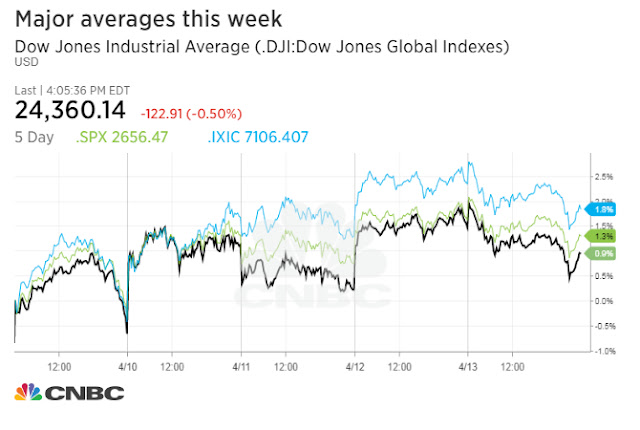Stocks closed slightly in negative territory this week, though they ended well off their lows. For the week, the Dow was off 0.6%, the S&P lost just 0.01%, and the Nasdaq declined 0.4%. Bonds were a big story again this week as their yields rose and prices fell. Gold moved lower again, down 0.9%. Oil was slightly lower on the week, off 0.5% to close at $67.97 per barrel. The international Brent oil, which is used for much of our gas here in the East, rose slightly to $74.44.
The headlines coming from the markets this week were all positive – corporate earnings are having their best quarter since 2011 and economic data released this week was solid. Unfortunately that didn’t translate into higher stock prices.
First we need to talk about the bond market, which made headlines as yields hit their highest level since 2013. Bonds are a broad category with many different maturities, but here we’re talking specifically about 10-year government bonds, which are seen as a benchmark for the bond sector.
First we need to talk about the bond market, which made headlines as yields hit their highest level since 2013. Bonds are a broad category with many different maturities, but here we’re talking specifically about 10-year government bonds, which are seen as a benchmark for the bond sector.
The rise in bond yields is important because it makes it more costly to borrow money – loans and mortgages are more expensive and credit card interest rates are higher. There is the concern that when borrowing slows down, the economy will also slow down.
The other benefit of low yields is they act like a pain killer for stocks. Bad news has less effect on the markets when rates are low. We’re seeing more volatility in the markets now that rates have risen and we could see more volatility if they rise further.
Yields have primarily been rising on expectation that the Fed will raise interest rates. Rates have been held at a record low level as a part of their stimulus, but as the economy improves and inflation rises, there is less need for stimulus.
Switching gears to corporate earnings, where the results from the first quarter still look solid. This week was the busiest one of the season, with nearly 1/3rd of companies in the S&P 500 reporting results.
According to Factset, earnings have grown by more than 20%, which makes it the best quarter since 2011. Additionally, 80% of companies have posted better results than analysts estimated. The image below shows just how unusual this is.
The other benefit of low yields is they act like a pain killer for stocks. Bad news has less effect on the markets when rates are low. We’re seeing more volatility in the markets now that rates have risen and we could see more volatility if they rise further.
Yields have primarily been rising on expectation that the Fed will raise interest rates. Rates have been held at a record low level as a part of their stimulus, but as the economy improves and inflation rises, there is less need for stimulus.
Switching gears to corporate earnings, where the results from the first quarter still look solid. This week was the busiest one of the season, with nearly 1/3rd of companies in the S&P 500 reporting results.
According to Factset, earnings have grown by more than 20%, which makes it the best quarter since 2011. Additionally, 80% of companies have posted better results than analysts estimated. The image below shows just how unusual this is.
The solid results have many wondering if this is as good as it gets. That idea was reinforced by Caterpillar’s earnings results this week.
Caterpillar is seen as a bellwether for industrial companies, so their results are watched closely. CAT had great results and forecasted solid earnings for the remained of the year – just not at as solid of a pace as the first quarter. The stock sold off strongly on the news and pulled the rest of the market with it.
As for economic data this week, the results were all positive. Consumer confidence moved higher, weekly jobless claims hit their best level since 1969, durable goods posted a solid increase, and housing reports all showed an increase from the previous month though prices continue to outpace wage growth.
Caterpillar is seen as a bellwether for industrial companies, so their results are watched closely. CAT had great results and forecasted solid earnings for the remained of the year – just not at as solid of a pace as the first quarter. The stock sold off strongly on the news and pulled the rest of the market with it.
As for economic data this week, the results were all positive. Consumer confidence moved higher, weekly jobless claims hit their best level since 1969, durable goods posted a solid increase, and housing reports all showed an increase from the previous month though prices continue to outpace wage growth.
Also, the GDP economic report came in at 2.3% growth, much higher than the 1.8% economists expected.
Lastly, we haven’t talked about bitcoin in a long time. Though it remains well off its highs, it has been creeping higher and approaching the $10,000 level. We found it interesting how bitcoin prices have moved similarly to the stock market – and can possibly even be seen as a leading indicator, showing when investors are moving into and out of riskier assets
Next Week
Next week again looks to be a busy one. Corporate earnings will still come in at a steady pace while we’ll get economic data on the strength of the manufacturing and service sectors, personal income and spending, housing, and the important monthly job report.
There is also a Fed policy meeting where they are expected to announce another increase in interest rates.
Lastly, several members of the Trump administration will be heading to China to discuss trade, so the trade debate may pick up again.
Investment Strategy
Still no change here. Stocks have moved off their oversold (cheap) levels and the gains of the last few weeks were due for a pause. They still appear to be on the cheap side overall, so we think the odds of a large pullback now are low.
The longer term direction of the market is a little difficult to predict. Fundamentals remain very good with pro-business policies out of Washington providing a solid tailwind. However, rising interest rates (which are like Kryptonite to stocks) could pull markets lower. It’s tough to say where we think the market will go the long run.
Bonds are also volatile at this time. Yields have broken out higher in the last two weeks (so prices moved lower), but we think they don’t have much room to run here.
As for the rest of the portfolio, bonds to protect against inflation, or TIPs, remain a good long term hedge for inflation. Floating-rate bonds will do well if interest rates do rise.
Some municipal bonds look attractive for the right client, too. We like buying individual, insured names for these bonds, avoiding muni index bonds if possible. We keep a longer term focus with these investments.
Gold is another good hedge for the portfolio. It is only a hedge at this point – rising on geopolitical issues as a flight to safety.
Finally, in international stocks, we prefer developed markets to emerging ones at this time.
This commentary is for informational purposes and is not investment advice, an indicator of future performance, a solicitation, an offer to buy or sell, or a recommendation for any security. It should not be used as a primary basis for making investment decisions. Consider your own financial circumstances and goals carefully before investing. Past performance cannot guarantee results.
Next week again looks to be a busy one. Corporate earnings will still come in at a steady pace while we’ll get economic data on the strength of the manufacturing and service sectors, personal income and spending, housing, and the important monthly job report.
There is also a Fed policy meeting where they are expected to announce another increase in interest rates.
Lastly, several members of the Trump administration will be heading to China to discuss trade, so the trade debate may pick up again.
Investment Strategy
Still no change here. Stocks have moved off their oversold (cheap) levels and the gains of the last few weeks were due for a pause. They still appear to be on the cheap side overall, so we think the odds of a large pullback now are low.
The longer term direction of the market is a little difficult to predict. Fundamentals remain very good with pro-business policies out of Washington providing a solid tailwind. However, rising interest rates (which are like Kryptonite to stocks) could pull markets lower. It’s tough to say where we think the market will go the long run.
Bonds are also volatile at this time. Yields have broken out higher in the last two weeks (so prices moved lower), but we think they don’t have much room to run here.
As for the rest of the portfolio, bonds to protect against inflation, or TIPs, remain a good long term hedge for inflation. Floating-rate bonds will do well if interest rates do rise.
Some municipal bonds look attractive for the right client, too. We like buying individual, insured names for these bonds, avoiding muni index bonds if possible. We keep a longer term focus with these investments.
Gold is another good hedge for the portfolio. It is only a hedge at this point – rising on geopolitical issues as a flight to safety.
Finally, in international stocks, we prefer developed markets to emerging ones at this time.
This commentary is for informational purposes and is not investment advice, an indicator of future performance, a solicitation, an offer to buy or sell, or a recommendation for any security. It should not be used as a primary basis for making investment decisions. Consider your own financial circumstances and goals carefully before investing. Past performance cannot guarantee results.


























